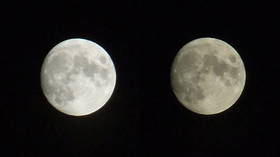Earth has had TWO MOONS for past three years… and no one noticed

The boffins at the Catalina Sky Survey have stumbled upon an amazing and slightly goofy discovery, apparently Earth has had a second moon for the past three years and nobody noticed.
This ‘mini-moon’ is actually an asteroid, measuring between 1.9 and 3.5 metres (6.2 and 11.5 feet) in diameter, that was temporarily captured by our planet’s gravity. Named 2020 CD3, we picked up our second moon some time in 2017 but, given how vast the sky is and how dark the moon is, it never caught anyone’s attention, until now.
BIG NEWS (thread 1/3). Earth has a new temporarily captured object/Possible mini-moon called 2020 CD3. On the night of Feb. 15, my Catalina Sky Survey teammate Teddy Pruyne and I found a 20th magnitude object. Here are the discovery images. pic.twitter.com/zLkXyGAkZl
— Kacper Wierzchos (@WierzchosKacper) February 26, 2020
Estimates of near-earth asteroids and meteors can reach into the millions but we’ve only officially discovered around 22,200. Most don’t give off much light, until they smash into our atmosphere, while others get trapped for a brief time before being fired back into space.
According to a 2012 supercomputer simulation, these mini-moons are extremely rare; of the 10 million virtual asteroids in the sim, only 18,000 got captured in Earth’s orbit.
Funnily enough an asteroid called 2006 RH120 was considered a mini-moon as it orbited the Earth for roughly 12 months between 2006 and 2007. There may have been another contender which made a fiery exit from this life in the skies above Australia recently.
Also on rt.com Australian desert FIREBALL may actually have been ‘MINIMOON,’ say scientistsThese mini-moons provide a good opportunity to study an asteroid without having to trek out into space and use up a ton of resources to reach them. Unfortunately, according to orbital simulations, 2020 CD3 will depart some time in April 2020.
Here's an animated GIF of our new mini-moon 2020 CD3, discovered by @WierzchosKacper. Rotating frame keeps the Earth/Sun line stationary. Orbital elements courtesy of IUA MPEC. https://t.co/dok3jn3G9hhttps://t.co/x1DXWLq2vmpic.twitter.com/O3eRaOIYjB
— Tony Dunn (@tony873004) February 26, 2020
Think your friends would be interested? Share this story!















